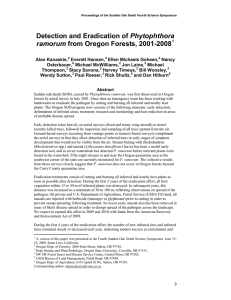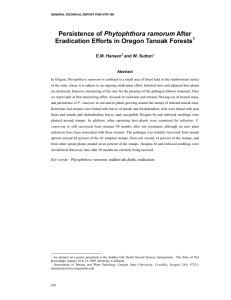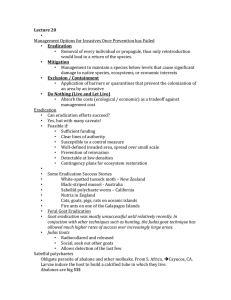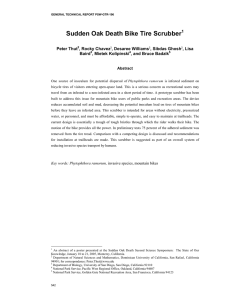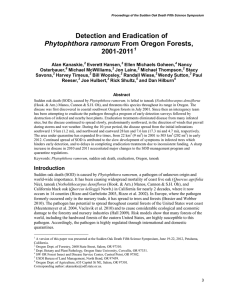Phytophthora ramorum Oregon Forests: Status After 6 Years Alan Kanaskie,
advertisement
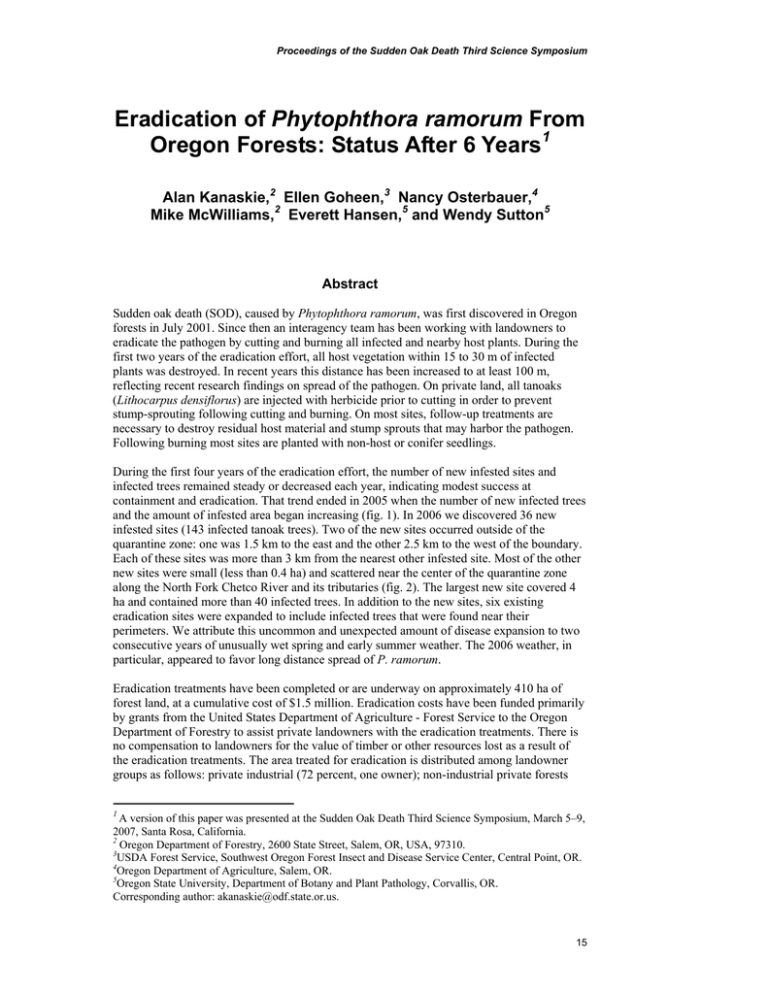
Proceedings of the Sudden Oak Death Third Science Symposium Eradication of Phytophthora ramorum From Oregon Forests: Status After 6 Years1 Alan Kanaskie,2 Ellen Goheen,3 Nancy Osterbauer,4 Mike McWilliams,2 Everett Hansen,5 and Wendy Sutton5 Abstract Sudden oak death (SOD), caused by Phytophthora ramorum, was first discovered in Oregon forests in July 2001. Since then an interagency team has been working with landowners to eradicate the pathogen by cutting and burning all infected and nearby host plants. During the first two years of the eradication effort, all host vegetation within 15 to 30 m of infected plants was destroyed. In recent years this distance has been increased to at least 100 m, reflecting recent research findings on spread of the pathogen. On private land, all tanoaks (Lithocarpus densiflorus) are injected with herbicide prior to cutting in order to prevent stump-sprouting following cutting and burning. On most sites, follow-up treatments are necessary to destroy residual host material and stump sprouts that may harbor the pathogen. Following burning most sites are planted with non-host or conifer seedlings. During the first four years of the eradication effort, the number of new infested sites and infected trees remained steady or decreased each year, indicating modest success at containment and eradication. That trend ended in 2005 when the number of new infected trees and the amount of infested area began increasing (fig. 1). In 2006 we discovered 36 new infested sites (143 infected tanoak trees). Two of the new sites occurred outside of the quarantine zone: one was 1.5 km to the east and the other 2.5 km to the west of the boundary. Each of these sites was more than 3 km from the nearest other infested site. Most of the other new sites were small (less than 0.4 ha) and scattered near the center of the quarantine zone along the North Fork Chetco River and its tributaries (fig. 2). The largest new site covered 4 ha and contained more than 40 infected trees. In addition to the new sites, six existing eradication sites were expanded to include infected trees that were found near their perimeters. We attribute this uncommon and unexpected amount of disease expansion to two consecutive years of unusually wet spring and early summer weather. The 2006 weather, in particular, appeared to favor long distance spread of P. ramorum. Eradication treatments have been completed or are underway on approximately 410 ha of forest land, at a cumulative cost of $1.5 million. Eradication costs have been funded primarily by grants from the United States Department of Agriculture - Forest Service to the Oregon Department of Forestry to assist private landowners with the eradication treatments. There is no compensation to landowners for the value of timber or other resources lost as a result of the eradication treatments. The area treated for eradication is distributed among landowner groups as follows: private industrial (72 percent, one owner); non-industrial private forests 1 A version of this paper was presented at the Sudden Oak Death Third Science Symposium, March 5–9, 2007, Santa Rosa, California. 2 Oregon Department of Forestry, 2600 State Street, Salem, OR, USA, 97310. 3 USDA Forest Service, Southwest Oregon Forest Insect and Disease Service Center, Central Point, OR. 4 Oregon Department of Agriculture, Salem, OR. 5 Oregon State University, Department of Botany and Plant Pathology, Corvallis, OR. Corresponding author: akanaskie@odf.state.or.us. 15 GENERAL TECHNICAL REPORT PSW-GTR-214 ( Figure 1—P. ramorum in Oregon forests: trend in number of new infected tanoak trees and new areas infested each year (not cumulative). The estimated number of infested acres includes new infested sites and expansions of eradication sites existing in previous years. Figure 2—Location of forest sites infested with P. ramorum in southwest Oregon, 2001 through December, 2006. All infested sites have received eradication treatments. The estimated number of infested acres includes new infested sites and expansions of eradication sites existing in previous years. 16 Proceedings of the Sudden Oak Death Third Science Symposium (18 percent, five owners); rural-residential (6 percent, 17 owners); United States Department of Interior - Bureau of Land Management (3 percent); USDA - Forest Service (<1 percent), and; and State of Oregon (<1 percent). To date we have had modest success at eradication and very good success at limiting spread and containing the pathogen to a relatively small area. Several of the treated sites appear pathogen-free two years after treatment, and the pathogen has not expanded from these sites. Repeated aerial surveys, ground surveys, and stream monitoring throughout southwest Oregon have failed to detect the pathogen in forests beyond the quarantine area near the town of Brookings. Extensive surveys from northern California to the Columbia River also have failed to detect the pathogen anywhere except in the Curry County quarantine area. The success of the program thus far can be attributed to a number of factors including: thorough aerial, ground, and stream monitoring surveys that facilitate rapid detection and response to the disease; consensus among the interagency pathologists involved; adequate federal funding, and; cooperation from affected landowners on private and federal lands. Continued and improved early detection surveys, rapid application of eradication treatments, and landowner assistance are critical to the long-term effectiveness of the containment and eradication program. Key words: Phytophthora ramorum, sudden oak death, Oregon, eradication. 17
